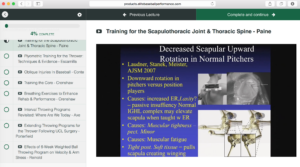
Not-So-Simple Sports Medicine Solutions
Last year, in her series on common injuries in professional baseball, MLB.com writer Lindsay Berra covered the topic of hamstrings strains, and even interviewed Cressey Sports Performance – Florida co-founder Shane Rye for the piece. You can give it a read here.
This article goes into some detail on why these injuries have been so prevalent and challenging in MLB over the years:
a) the nature of baseball (stand around for a while, then have to sprint full-bore without a re-warm-up)
b) poor strength and conditioning practices (e.g., lifting too much to the exclusion of actual sprinting and mobility work)
c) muscular imbalances (e.g., poor glute recruitment, quad/hamstrings imbalances, etc)
I’d also add previous injuries as a big risk factor. Many times, it’s one player who is reinjuring the same old hamstrings injury to “inflate” league-wide numbers.
For a while, the solution was to get the hamstrings stronger relative to the quads. Then the answer was to bring an underactive synergist (gluteus maximus) up to par. And, lately everyone has jumped on board the Nordic hamstrings curl bandwagon; they apparently not only help prevent hamstrings strains, but cure cancer, acne, and hemorrhoids – and will even make girls like you. I joke, but it’s actually a perfect lead-in to the next point: sports medicine doesn’t have a perfect answer to the hamstrings problem in baseball.
Luckily, as with everything in life, the internet has all the solutions. Monday Morning Quarterbacks abound, and all these doctors, rehabilitation specialists, and strength and conditioning professionals really could have just gotten the billion-dollar solution they needed on Twitter.
As an example, when I linked to the aforementioned article on Twitter, one reply was particularly entertaining:
“Simple fix already seen especially in female soccer training. With the ‘best’ sports med docs in pro sports crazy it hasn’t been corrected.”
This response couldn’t be further from the truth.
First, comparing males and females is an issue in itself. Females have far more joint laxity, so they’re significantly less likely to have “tight” hamstrings (for a variety of reasons) that could potentially be injured. Moreover, male athletes are stronger and more powerful than females, so there are gender-specific differences in the actual forces experienced. The faster you are, the more likely you are to pull a hammy. This is also why we see far more hamstrings strains in baseball than we do in softball even if they’re both equally “far behind” in prevention strategies.
Second, soccer and baseball couldn’t be more different. Soccer is continuous play for 90 minutes, and as I recall, the average midfielder covers approximately seven miles per game. Baseball games might last four hours, and a player might not cover seven miles in an entire month – and all of it is done at a high percentage of maximum speed. They stand or sit around, and then are expected to sprint full-tilt without much warning. Improving work capacity in soccer players can definitely reduce the risk of injury late in matches, but won’t do much in the baseball world because they never really get fatigued; rather, they stiffen up from doing nothing.
Third, the competitive calendar is different. If you look at the Major League Soccer schedule, most clubs play 6-7 matches in June. Major League Baseball teams play this many games each week – and do so with a much more challenging travel schedule. That crazy schedule pushes out a lot of training time, and makes optimizing recovery incredibly difficult.
Fourth – and this is a very subjective, anecdotal observation – baseball players are less likely to take good care of themselves off the field. Major leaguers are far more likely to go out and crush eight beers after a game than the 16-year-old female soccer player that’s been positioned atop a pedestal of sports medicine excellence. They also don’t test for recreational drugs in 40-man roster players in MLB. Don’t you think the guy who went on a bender the night before a doubleheader is more likely to strain his hamstrings than Susie Soccer who still lives with her parents?
I could go on and on about the differences, but I don’t think that the point needs to be illustrated any further. Every sport has different physiological, biomechanical, social, and psychological factors that need to be taken into account in the injury prevention battle. Most people on social media can’t possibly even come close to fathoming all these different contributing factors.
Now, I’m all for borrowing training ideas from different facets of the sports medicine industry. I’ve learned a ton from coaches in everything from sprinting, to tennis, to track & field, to powerlifting. Nobody has the perfect solution for your sport-specific problem, though (even though social media might tell you otherwise). Still look to to learn from these other professionals, but critically evaluating everything you come across.
Above all else, make sure that you’re still working hard to get educated in your specific sporting discipline. As an example, it’s one reason why I highly recommend the American Sports Medicine Institute (ASMI) Injuries in Baseball course. This resource brings together some of the most renowned surgeons, rehabilitation specialists, and strength and conditioning professionals in the baseball world each year. And, it’s on sale for $150 off (50% off) this week only. If you work with overhead athletes in any capacity, I’d encourage you to look into it. You can check it out HERE.





